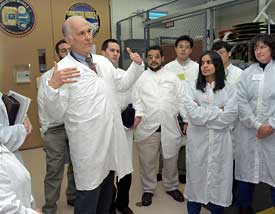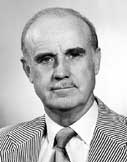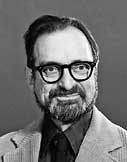Gerard Faeth
Gerard Faeth, an aerospace engineering professor and top NASA advisor who led a 2003 Columbia Space Shuttle experiment examining how to reduce soot and other pollutants in the burning of fuel, passed away suddenly Jan. 24.

At the time of his death, Faeth was the Arthur B. Modine Distinguished University Professor of Aerospace Engineering, a title he earned in the fall when he was named one of four Distinguished University Professors for the 2004-05 academic year. It’s one of the highest honors a U-M faculty member can receive.
“Jerry Faeth was one of our college’s most distinguished faculty members and represented the best of Michigan Engineering,” says Stephen W. Director, the Robert J. Vlasic Dean of the College of Engineering. “He was a world-renowned scholar with expertise across multiple disciplines. He was an accessible teacher and advisor. I truly valued his advice. He had tremendous impact on the University of Michigan and the international academic community and will be sorely missed.”
Faeth died of a heart attack in his Ann Arbor home. He was 68.
In 1991, he was elected to the prestigious National Academy of Engineering. In 1993, he received Engineering’s Stephen S. Attwood Award, the highest honor the college can bestow on a faculty member.
During his professional career, Faeth led numerous NASA-funded research projects, including a 2003 experiment aboard the Columbia Space Shuttle, which tragically fell apart February 2003.
Faeth also was an important member of the NASA advisory community, serving on many committees, the most important of which was the NASA Advisory Council, which reports directly to the agency’s top administrator.
David Urban, a researcher at the NASA Glenn Research Center in Cleveland, says Faeth was one of the most respected research engineers in the world.
“He was organized and hard-working,” says Urban, chief of the center’s Combustion and Reacting Systems Branch. “But he had a grandfatherly manner and really made you feel like you mattered to him. He would push you as he pushed himself, but he paid attention to how you were doing.”
In preparation for the 2003 Columbia Space Shuttle mission, Faeth worked to train the crew for two years before their flight.
The experiment consisted of observing a flame that did not flicker and that was not disturbed by gravity. About half the data was downloaded before the shuttle came apart over Texas.
What he and his students learned from this experiment, both from the Columbia trip and previous journeys in space, could lead to ways of controlling soot, the deadliest of all pollutants, Faeth said of the study. The latest experiment taught him some simple ways to predict soot in flames.
Four of those on board the Columbia had extensive training on Faeth’s project: Michael Anderson, Kalpana Chawla, David Brown and Ilan Ramon, who did the bulk of the testing. Faeth’s last contact with the crew was the Wednesday after liftoff, when he spoke to Anderson through a NASA coordinator.
The research sought to find cleaner methods for the burning of fuel—such as in diesel trucks, coal-fired power plants and jet airliners—and improve air quality. Faeth wanted to find cleaner combustion methods that could be applied in other industries.
He led similar work aboard two shuttle flights in 1997.
Faeth came to U-M in July 1985 as an associate research scientist; later that year he became a full-time professor of aerospace engineering.
Faeth’s broader interests included theoretical and experimental research concerning combustion, heat transfer and fluid dynamics. He authored or co-authored more than 500 journal articles and papers.
During his two decades at the college, he was elected fellow of the American Institute of Aeronautics and Astronautics, the American Association for the Advancement of Science, and the American Physical Society. Prior to coming to U-M, he was elected fellow of the American Society of Mechanical Engineers.
On Feb. 8, Faeth was scheduled to give a lecture—”The Physical, Optical and Reactive Properties of Pollutant Soot in Flame Environments”—as part of his Distinguished University Professorship.
Faeth received his undergraduate degree from Union College in New York and his master’s and doctoral degrees from Pennsylvania State University.
A memorial service was held Jan. 29 at St. Andrews Episcopal Church, Ann Arbor.
George E. Hay
George E. Hay, professor emeritus of mathematics, died Jan. 12. He was born in 1914 in Durham, Ontario. He received three degrees in mathematics from the University of Toronto, culminating with his doctorate in 1939.

In 1940, Hay joined the Department of Mathematics at U-M as an instructor. He steadily rose through the ranks, becoming a professor in 1956. He worked for the U. S. Navy at Brown University as an associate in the Office of Scientific Research and Development from 1944-45.
Hay specialized in applied mathematics, specifically the theory of elasticity and mechanics. He published a book in 1954 entitled “Vector and Tensor Analysis.” During his tenure, Hay directed the dissertations of four graduate students. He was chairman of the Department of Mathematics from 1957-67, and associate dean of the Horace H. Rackham School of Graduate Studies from 1967-76. He retired from the active faculty in 1984.
As chairman, Hay is remembered as having quiet and capable leadership. He helped guide the department through a difficult 10 years when financial pressures and a strong demand for highly trained mathematicians seriously threatened mathematics at the University.
He was known as a straightforward, honest and kind leader. “Many of the senior or recently retired faculty in the Mathematics Department today were recruited and hired by George Hay,” says Don Lewis, professor emeritus of mathematics and former department chair. “George was very effective in creating a collegial environment within the department, particularly through his own personal consultations with faculty and via social events he and his wife hosted.”
“George’s kind personality and demeanor was very influential in my decision to come to Michigan from MIT,” Paul Federbush, professor emeritus of mathematics says.
Colleagues outside the Department of Mathematics also fondly remember Hay.
“As chair of the Psychology Department at the time of George’s chairmanship of math, I had many opportunities to benefit from his cooperation and good sense,” says Bill McKeachie, professor emeritus of psychology. “We worked together on several occasions to develop policies that would help us strengthen the University and our
departments.”
Hay is survived by his sisters, Ellen Cannons and Frances Tracy Hay Sawyer; children, Ted of Adrian; John (Debby) of Brighton; and Kathryn (David) of Lewisville, Texas. On Dec. 25, he was preceded in death by his beloved wife of 61 years, Lillian.
—Submitted by the Department of Mathematics
Edith S. Lisansky Gomberg
Edith S. Lisansky Gomberg, professor emeritus of psychiatry and social work, died in her sleep Jan. 8.
Gomberg earned her bachelor’s degree in psychology at Brooklyn College in 1938, her master’s degree in psychology from Columbia University in 1940, and her doctorate in psychology from Yale University in 1949.
She joined the U-M School of Social Work (SSW) faculty in 1974, and her pioneering research focused on alcohol addiction in older adults, particularly women. She also was a researcher in the Department of Psychiatry’s Alcohol Research Center; held research appointments at the Ann Arbor VA Medical Center; was a research scientist at the Institute of Gerontology; and was a faculty associate at the Institute for Social Research.
She was named professor emeritus of social work in 1990.
During her career, Gomberg served in several leadership positions at SSW, the University and with the state of Michigan. She also served many national and international scientific organizations.
“Professor Gomberg was a pioneer,” SSW Dean Paula Allen-Meares says. “She charted a research agenda that was unique and cutting edge. Thanks to her, issues of substance abuse among women gained attention in psychiatry and in medicine.”
Funeral services were Jan. 12. Memorials may be sent to the Humane Society of Huron Valley, 3100 Cherry Hill Road, Ann Arbor, MI, 48105 or via the Internet at http://www.hshv.org.
—Submitted by Terri Torkko, SSW
Frank Harary
Frank Harary, professor emeritus of mathematics, died Jan. 4. Harary was born in New York City on March 11, 1921, the oldest child of immigrant parents. He received his bachelor’s and master’s degrees from Brooklyn College, and his doctorate from the University of California, Berkeley.

Harary held a faculty position in the U-M Department of Mathematics from 1948-86. He also was a member of the Institute for Social Research (ISR) from 1950-82. He was a distinguished professor (and later distinguished professor emeritus) in the Computer Science Department at New Mexico State University in Las Cruces from 1987 until the time he passed away.
Harary was widely recognized as the “father” of modern graph theory, a discipline of mathematics he helped found, popularize and revitalize. He wrote numerous books and articles, including the 1969 book, “Graph Theory,” which has become a modern classic that helped define, develop, direct and shape the field of modern graph theory. In 1955, Harary taught U-M’s first graph theory and combinatorial theory courses.
He was founder of the Journals of Combinatorial Theory and of Graph Theory and served on the editorial boards of many more.
During his long and productive career, Harary authored/co-authored more than 700 scholarly papers—in areas as diverse as anthropology, biology, chemistry, computer science, geography, linguistics, music, physics, political science, psychology, social science and mathematics— which brought forth the usefulness of graph theory in scientific thought.
Harary guided 16 doctoral students, many of whom have gone on to be distinguished scholars themselves. As a member of the Research Center for Group Dynamics at ISR, he studied the feasibility of applying mathematical models to the study of structures in groups of people.
Harary was awarded six honorary doctorate degrees, and has received numerous other awards and recognition for his work. He had a deep and abiding love for mathematics and traveled the globe preaching the gospel of graph theory. He delivered speeches at more than 1,000 conferences and was invited to lecture in more than 87 countries. He particularly was proud of having given lectures in cities with names beginning with every letter of the alphabet. He finally got his ‘X’ with a lecture in the excavated Roman amphitheater in Xanten, Germany.
As a result of his contributions to the field, colleagues, peers and students fondly referred to Harary as Mr. Graph Theory. He is survived by four children: Mimi, Natalie, Tom and Joel.
—Submitted by the Dept. of Mathematics

